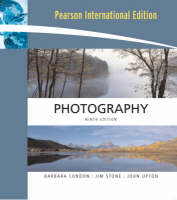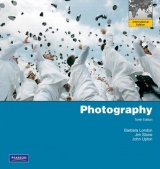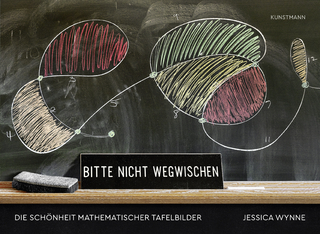
Photography
Pearson (Verlag)
978-0-13-206117-9 (ISBN)
- Titel erscheint in neuer Auflage
- Artikel merken
Why is this the #1 photography text year after year? Because no other source teaches students the skills they need to use the medium confidently and effectively, emphasizing both technique and visual awareness.
Preface viii
1 Getting Started 2
Camera and Film 4
Getting Your Camera Ready 5
Focusing and Setting the Exposure 6
Taking Your Picture 8
What Will You Photograph? 9
Some Basic Guidelines to Get You Started 9
Photographing People 10
Photographing Places 12
2 Camera 14
Basic Camera Controls 16
The Shutter 18
The Shutter and Light 18
The Shutter and Motion 20
Conveying Motion in a Still Photograph 22
The Aperture 24
The Aperture and Light 24
The Aperture and Depth of Field 26
Using Shutter and Aperture Together 28
Choosing a Camera 30
Keeping the Camera Steady 33
photographer at work: Photojournalist James Nachtwey 34
3 Lens 36
From Pinhole to Lens 38
Lens Focal Length 40
Normal Focal Length 42
Long Focal Length 44
Short Focal Length 46
Zoom Lenses 48
Special-Purpose Lenses 49
Focusing Your Lens 50
Manual Focus 50
Automatic Focus 52
Focus and Depth of Field 54
Controlling Depth of Field 56
Zone Focusing 58
Focusing on the Hyperfocal Distance 59
Perspective 60
Guidelines for Buying a Lens 62
Getting the Most from Your Camera and Lens 63
photographer at work: Mary Ellen Mark 64
4 Exposure, Sensors, and Film 66
Exposure Basics 68
Equivalent Exposures 68
How Exposure Meters Work 69
In-Camera Exposure Meters 70
Automatic Exposure 71
How to Meter 72
An Overall Reading of a Scene with Average Tones 72
Using Different Types of Meters 73
Metering High-Contrast Scenes 74
Exposing for Specific Tones and Bracketing 76
Hard-to-Meter Scenes 77
Responding to Light 78
Silver and Pixels 78
Selecting and Using Film 79
Exposure Latitude and Dynamic Range 80
How Much Can Exposures Vary? 80
Film and Sensor Speed 82
Speed and ISO 82
Grain and Noise 83
Extending Beyond Visible Light 84
Infrared Photographs 84
Special Purpose Films 86
Instant and Chromogenic Films 86
Polarizing Filters 87
Using Filters 88
Using Exposure 90
photographer at work: Advertising Photographer Clint Clemens 92
5 Developing the Negative 94
How to Process Black-and-White Roll Film 96
Equipment and Supplies You’ll Need 96
Processing Chemicals and How to Handle Them 97
Chemical Safety 98
Processing Black-and-White Roll Film Step by Step 100
How Film Processing Affects Your Picture 106
Exposure and Development: Under, Normal, Over 108
6 Printing in a Darkroom 110
Black-and-White Printing 112
Equipment and Supplies for Printing 112
The Enlarger 114
Printing Papers 116
Making a Black-and-White Print Step by Step 118
A Contact Sheet: A Whole Roll at Once 118
Setting Up an Enlargement 120
A Test Strip for Your Print 122
A Trial Print–and Then a Final Print 123
Processing a Black-and-White Print 124
Evaluating Density and Contrast in a Print 128
Controlling Contrast 130
Graded- and Variable-Contrast Papers 130
Dodging and Burning 132
Cropping 134
Archival Processing for Maximum Permanence 135
Toning for Color and Other Effects 136
7 Color 138
Color: Additive or Subtractive 140
Color Photographs: Three Image Layers 141
Color Characteristics 142
Color Balance 144
Color Changes through the Day 144
Color Casts 146
Color Temperature 147
Filters to Balance Color 148
Developing Color Film 150
Making a Color Print From a Negative 151
Equipment and Materials You’ll Need 151
Exposing a Test Print 152
Judging Density in a Print Made from a Negative 154
Judging Color Balance in a Print Made from a Negative 155
More About Color Balance and Print Finishing 157
Making a Color Print from a Transparency 158
Judging a Print Made from a Transparency 159
photographer at work: Another Angle on Sports–Walter Iooss, Jr. 160
8 Setting up a Digital Darkroom 162
Hardware and Software 164
An Overview 164
Capturing Detail: Resolution and Bit Depth 165
Photographs Are Files 166
File Formats 166
Importing Your Images 168
Downloading and Scanning 168
Making a Scan 169
Color Management 170
Histograms 172
Anatomy of a Digital Image 172
Three Histograms for Color 173
Setting Up a Workflow 174
photographer at work: Digital Storyteller–Pedro Meyer 176
9 Image Editing 178
Digital Post-Processing and Editing: Getting Started 180
Choosing Software 180
Your Work Area and Tools 181
Setting Up an Image to Edit 182
Channels 183
Color or Black and White? 183
Adjusting Color and Value 184
Different Approaches 184
Using Levels 185
Curves 186
Adjusting All or Part of an Image 188
Selection Tools 188
Using Layers 189
Other Editing Commands 190
High Dynamic Range 190
Filters for Special Effects 191
Retouching and Sharpening 192
Compositing 194
An Image-Editing Workflow 196
10 Digital Printing 198
Printers and Printing 200
Printer Choices 200
Drivers and RIPs 201
Profiles and Soft Proofing 202
Papers and Inks 203
Printing Options 204
Panoramic Photographs 204
Printing in Black and White 206
Displaying Your Work 208
The Internet–Gallery and Resource 208
Ethics: How Far Can You Go? 209
11 Organizing and Storing Your Work 210
Image Storage 212
Size Matters 212
Metadata: Data About Your Files 213
Software to Keep You Organized 214
Archiving Digital Images 215
Archiving Film and Prints 216
12 Print Finishing and Display 218
Spotting to Remove Minor Flaws 220
Mounting a Print 221
Equipment and Supplies You’ll Need 221
Dry Mounting 222
Cutting an Overmat 224
Framing and Glazing 225
13 Lighting 226
Direction of Light 228
Degree of Diffusion: From Hard to Soft Light 230
Available Light–Outdoors 232
Available Light–Indoors 233
Artificial Light 234
Lights and Other Lighting Equipment 234
Qualities of Artificial Light 235
The Main Light: The Dominant Source 236
The Fill Light: To Lighten Shadows 238
Lighting with Flash 240
Flash Equipment 241
Basic Flash Techniques 242
Manual Flash Exposures 244
Automatic Flash Exposures 245
Fill Flash: To Lighten Shadows 246
Controlling Background Brightness 248
Simple Portrait Lighting 250
Multiple-Light Portrait Setups 252
Lighting Textured Objects 254
Lighting Reflective Objects 255
Lighting Translucent Objects 256
Using Lighting 257
photographer at work: Dance Photographer Lois Greenfield 258
14 Extending the Image 260
Using Scale 262
Pictures Very Large and Very Small 262
Multiple Images 264
More is Better 264
Fabricated to be Photographed 266
The Photograph as Object 268
Using Projections 270
Making a Book 271
Alternative Processes 272
Cyanotype Printing 272
Platinum and Palladium Printing 273
Gum Bichromate Printing 274
Image Transfer 275
A Photogram: A Cameraless Picture 276
Cross Processing 278
A Sabattier Image: Part Positive, Part Negative 279
Pinhole Photography 280
How to Make a Close-Up Photograph 282
Close-Up Exposures 283
Copying Techniques 284
15 View Camera 286
Inside a View Camera 288
View Camera Movements 290
Rise and Fall 290
Shift 292
Tilt 294
Swing 296
Using a View Camera to Control the Image 298
Controlling the Plane of Focus 299
Controlling Perspective 300
Equipment You’ll Need 302
What to Do First–and Next 303
Loading and Processing Sheet Film 304
16 The Zone System 306
The Zone System Scales 308
Using the Zone Scale While Metering 310
Placing a Tone, Seeing Where Other Tones Fall 310
How Development Controls Contrast 312
Putting It All Together 314
Roll Film and Color Film 315
photographer at work: Using the Zone System–John Sexton 316
17 Seeing Photographs 318
Basic Choices 320
Content 320
Framing the Subject 322
Backgrounds 324
Basic Design 326
Spot/Line 326
Shape/Pattern 328
Emphasis/Balance 330
More Choices 332
Using Contrasts of Sharpness 332
Using Contrasts of Light and Dark 334
Placing the Subject within the Frame 336
Perspective and Point of View 338
Looking at–and Talking About– Photographs 340
Showing Your Work to Editors and Others 342
18 History of Photography 344
The Invention of Photography 346
Daguerreotype: “Designs on Silver Bright” 347
Calotype: Pictures on Paper 348
Collodion Wet-Plate: Sharp and Reproducible 349
Gelatin Emulsion/Roll-Film Base: Photography for Everyone 350
Color Photography 351
Early Portraits 352
Early Travel Photography 354
Early Images of War 355
Time and Motion in Early Photographs 356
The Photograph as Document 357
Photography and Social Change 358
Photojournalism 360
Photography as Art in the 19th Century 364
Pictorial Photography and the Photo-Secession 365
The Direct Image in Art 366
The Quest for a New Vision 367
Photography as Art in the 1950s and 1960s 368
Photography as Art in the 1970s and 1980s 370
A Gallery of Contemporary Photography 372
Troubleshooting 388
Glossary 399
Bibliography 404
Credits 408
Index 410
| Erscheint lt. Verlag | 31.7.2008 |
|---|---|
| Sprache | englisch |
| Maße | 253 x 273 mm |
| Gewicht | 1674 g |
| Themenwelt | Kunst / Musik / Theater ► Fotokunst |
| ISBN-10 | 0-13-206117-1 / 0132061171 |
| ISBN-13 | 978-0-13-206117-9 / 9780132061179 |
| Zustand | Neuware |
| Haben Sie eine Frage zum Produkt? |
aus dem Bereich



